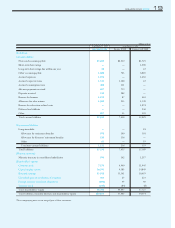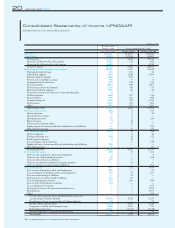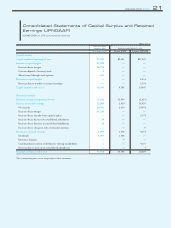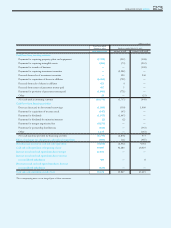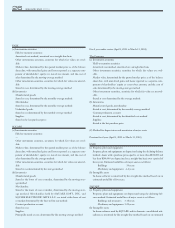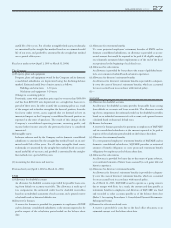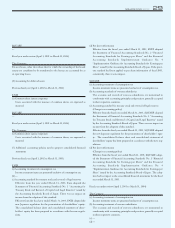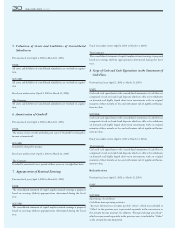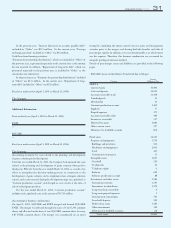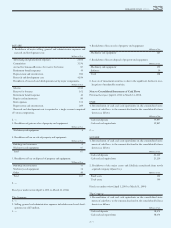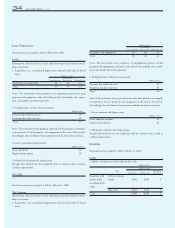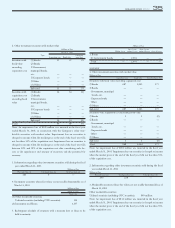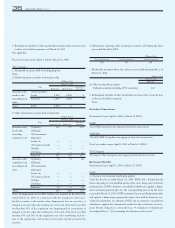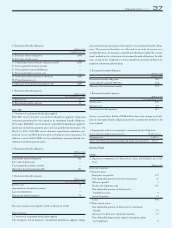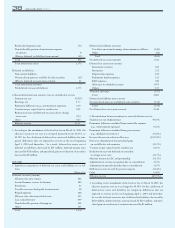Square Enix 2004 Annual Report Download - page 30
Download and view the complete annual report
Please find page 30 of the 2004 Square Enix annual report below. You can navigate through the pages in the report by either clicking on the pages listed below, or by using the keyword search tool below to find specific information within the annual report.
28 SQUARE ENIX 2004
Fiscal year under review (April 1, 2003 to March 31, 2004)
The Company
(a) Allowance for doubtful accounts
An allowance for doubtful accounts provides for possible losses arising
from default on accounts receivable. The allowance is made up of two
components: the estimated credit loss for doubtful receivables based on
an individual assessment of each account, and a general reserve calculat-
ed based on historical default rates.
(b) Reserve for bonuses
A reserve for bonuses provides for payments to employees of the
Company and its consolidated subsidiaries at the amount expected to be
paid in respect of the calculation period ended on the balance sheet
date.
(c) Allowance for retirement benefits
An allowance for retirement benefits is provided at the amount incurred
during the fiscal year, which is based on the estimated present value of
the projected benefit obligation. Unrecognized actuarial diffences are
fully amortized in the next year in which they arise. In addition, the
domestic consolidated subsidiaries provide for the reserve for retire-
ment benefits by 100 percent of such benefits that the subsidiaries
would be required to pay under the lump-sum retirement plan if all eli-
gible employees voluntarily terminated their employement at the bal-
ance sheet date.
(Additional information)
Until the previous fiscal year, the Company had provided for the
reserve for retirement benefits by 100 percent of such benefits that the
Company would be required to pay if all eligible employees voluntarily
terminated their employement at the balance sheet date. Effective from
the current fiscal year, as the number of Company employees exceeded
300 due to the merger with SQUARE, the Company changed its
accounting policy for reserve for retirement benefits to the method as
mentioned above. As a result of this change, retirement expense
increased by ¥437 million, and recurring profit and income before
income taxes each decreased by ¥416 million.
Moreover, this change in accounting method was adopted in the second
half of the fiscal year under review due to the merger with SQUARE
and the increase in the Company’s employee numbers to over 300.
Reserve for retirement benefits for the first half were calculated using
the previous method. Adjusting first-half accounts to reflect the change
in accounting method, recurring profit and income before income taxes
would increase by ¥393 million.
(d) Allowance for sales returns
An allowance is provided for losses due to the return of published mate-
rials, at an amount calculated based on historic experience, prior to the
current fiscal year. In addition, allowance is provided for losses due to
the return of game software, at an estimated amount of future losses
assessed by each game title.
(e) Allowance for directors’ retirement benefits
An allowance for directors’ retirement benefits is provided to adequate-
ly cover the costs of directors’ retirement benefits, which are accounted
for on an accrual basis in accordance with internal policy.
(f) —
(4) Translation of foreign currency transactions and accounts
Previous fiscal year (April 1, 2002 to March 31, 2003)
ENIX
All monetary assets and liabilities of the Company and its domestic consoli-
dated subsidiaries denominated in foreign currencies are translated into
yen at the year-end rate. The resulting translation gains or losses are
charged or credited to income. Overseas subsidiaries are translated into yen
at the year-end rate. The resulting translation adjustments are recorded in
shareholders’ equity as “Foreign Currency translation adjustment”.
SQUARE
All monetary assets and liabilities of the Company and its domestic consoli-
dated subsidiaries denominated in foreign currencies are translated as of
the balance sheet date at the year-end rate. The resulting translation gains
or losses are charged or credited to income. All monetary assets and liabili-
ties of overseas subsidiaries are translated as of the balance sheet date at the
year-end rate and all income and expense accounts are translated at average
rates for their respective periods. The resulting translation adjustments are
recorded in shareholders’ equity as “Foreign Currency translation adjust-
ment”.
Fiscal year under review (April 1, 2003 to March 31, 2004)
The Company
All monetary assets and liabilities of the Company and its domestic consoli-
dated subsidiaries denominated in foreign currencies are translated as of
the balance sheet date at the year-end rate. The resulting translation gains
or losses are charged or credited to income. All monetary assets and liabili-
ties of overseas subsidiaries are translated as of the balance sheet date at the
year-end rate and all income and expense accounts are translated at average
rates for their respective periods. The resulting translation adjustments are
recorded in minority interests in consolidated subsidiaries and in share-
holders’ equity as “Foreign Currency translation adjustment”.
(5) Accounting for leases
Previous fiscal year (April 1, 2002 to March 31, 2003)
ENIX
Finance leases, other than those that for which the ownership of the leased
assests are considered to be transferred to the lessees are accounted for as
an operating leases.



